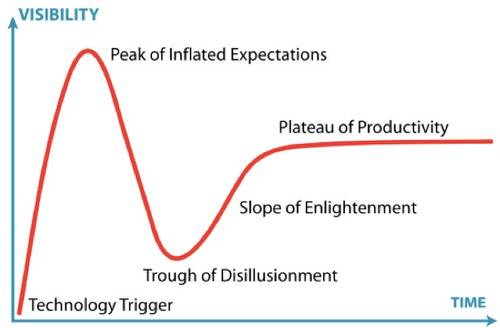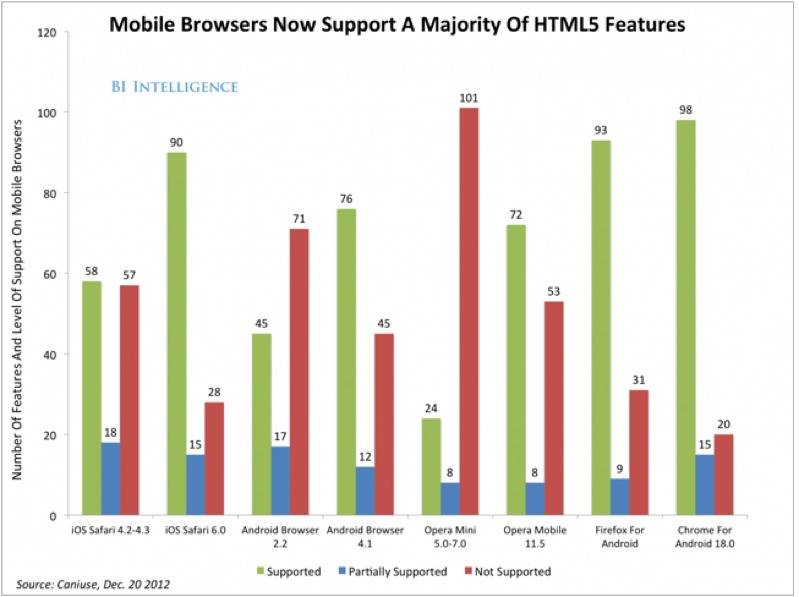Guest author Rob Grossberg is the CEO of TreSensa, a game development and distribution company for the mobile Web.
In April of 2010, Steve Jobs penned an open letter titled “Thoughts on Flash” in which he stated the “new open standards created in the mobile era, such as HTML5, will win”. Facebook seemingly later validated Jobs’ thought when rumor came of a major initiative called Project Spartan that would make Facebook apps completely based on HTML5.
HTML5 was the next big thing. The unifier. The Holy Grail. Code once, it works everywhere. That was the promise.
Hip, Hop, Hype & HTML5
And so up rose the hype and expectations around HTML5, the mark-up language and set of web standards promulgated by the World Wide Web Consortium and adopted in large part over the past four years by all major browsers.
It was during this period in 2011 and 2012 that startups emerged in publishing, gaming, financial services, etc. touting HTML5 as a key to their offering, attracting investors who bought in and invested big bucks to support the early adopters.
During this same period of time, the inevitable debate began. Who will be the winner on mobile—Native Apps or HTML5? It was framed by most as a winner takes all.
In the summer of 2012 Facebook dumped its HTML5-based mobile app due to performance issues. Project Spartan was dead. A few months later, Mark Zuckerberg said in an interview that “betting too much on HTML5 as opposed to native” app development was Facebook’s biggest mistake. Just like that, it was no longer cool to talk about HTML5. We had a winner of the Native vs. HTML5 debate by knockout. HTML5 is dead! Long live Native!
HTML5 & The Trough Of Disillusionment
The evolution and trajectory of HTML5 described above is very common with emerging and disruptive technologies. The truth? HTML5 is far from dead. Gartner Research has analyzed the patterns tied to new technology adoption and dubbed it the “Hype Cycle”. See the chart below to get a flavor for the different stages of the cycle. HTML5 has been riding this same curve, almost to a tee.

When HTML5 received the major hype from the industry giants, it was still a very nascent technology with lots of holes. It was not ready for prime time. Instead of recognizing this fact and tempering its application, many companies commissioned ambitious HTML5-based projects and were deeply disappointed and critical when their expectations were not met.
Stability & Adoption
Despite the various high-profile failures, all the benefits of HTML5 that started the hype in the first place did not magically disappear. Over the past 18 months many of the holes in the technology have been plugged as the operating systems, mobile browsers and devices have advanced and gotten stronger with improved HTML5 functionality tied to each new release. People also are replacing their smart phones fairly often, so the majority of smart phone and tablet users now have devices much better suited to support HTML5.
Below is a chart from the end of last year showing the HTML5 feature progress within major browsers. It has only gotten better in 2013.

And while some major technology and gaming companies swore off HTML5 when their expectations were shattered, others stepped up to embrace HTML5. Companies like Disney, NBCU and Viacom and brands like Progressive Insurance and HBO. Why? Very simple—it makes business sense. Building apps in HTML5 is cost effective and has allowed these companies to provide engaging content to their users on mobile devices in unique ways without sending them into the arms of Apple or Google. This was part of the initial appeal of HTML5 and the value of that is now becoming reality.
Other technology companies like Mozilla, Samsung, Intel and Amazon have started to develop HTML5 offerings that are now beginning to emerge from early testing. This summer Amazon announced to the developer community a major Web app initiative tied to HTML5. Samsung and Intel are sponsors of the HTML5-based open source Tizen an operating system based on Nokia and Intel’s old MeeGo project. Mozilla launched its new HTML5-based operating system in Brazil and will be launching later in Mexico, Peru and Uruguay.
If we use Gartner’s methodology, next comes the Slope Of Enlightenment. Companies, channels and applications are doing things with HTML5 that nobody envisioned a few years back. For example Kik—a popular mobile messaging app with close to 100 million registered users—bet on HTML5 and now supports multiple forms of rich media content (videos, games, memes) within its chat messenger service. No download required, just instant fun.
Did all the early hype ultimately help or hurt the progress of HTML5? Probably a bit of both. On one hand, the hype helped bring HTML5 to the forefront and led thousands of companies (Disclosure: mine included) to adopt it for their products and services. The early adopters who were able to survive the downturn find themselves in enviable positions to capitalize on their lead.
HTML5 is now close to prime time and more and more business are looking to HTML5 to solve market challenges. When the pendulum swung away from HTML5 in 2012, it swung pretty far and scared away many potential innovators. How much farther along might HTML5 be if expectations had been tempered and more companies focused on its potential rather than its failures?









